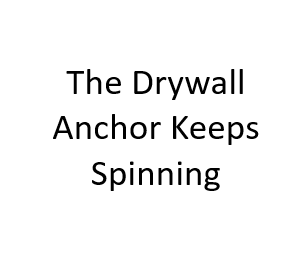Drywall anchors are essential hardware when it comes to hanging objects on your walls securely. They provide the necessary support to keep heavy items in place. However, if you’ve ever experienced the frustrating issue of a drywall anchor spinning, you’re not alone. In this blog post, we’ll delve into the reasons behind this common problem and explore solutions to ensure your wall hangings stay put.
Understanding Drywall Anchors
Before we dive into the spinning issue, let’s get a clear understanding of what drywall anchors are and why they are necessary. Drywall, a common wall material in homes, is relatively fragile compared to materials like wood or concrete. When you hang something heavy on drywall, like a mirror or a shelf, the drywall alone may not provide enough support to hold the weight.
That’s where drywall anchors come into play. These small but mighty devices are designed to distribute the weight of the object and provide a secure attachment point in the wall. There are various types of drywall anchors, including plastic anchors, toggle anchors, and metal anchors, each with its unique characteristics and installation methods.
The Spinning Problem
One of the most frustrating issues people encounter with drywall anchors is when they start spinning during installation. This occurs when you’re trying to screw in a screw or bolt into the anchor, and instead of gripping the wall securely, the anchor just keeps rotating within the hole.
So, why does this happen?
- Incorrect Installation: One of the primary reasons for spinning drywall anchors is incorrect installation. If you don’t push the anchor deep enough into the wall or if the hole is too large, the anchor won’t have a proper grip, leading to spinning.
- Wall Material Matters: The type of wall material also plays a role. Drywall anchors are specifically designed for use with drywall. If you’re attempting to use them in other materials like plaster or concrete, they may not work effectively and can spin.
- Over-Tightening: Applying too much force while tightening the screw can cause the anchor to spin. Drywall anchors are designed to hold a specific weight, and exceeding that limit can lead to problems.
Solutions to the Spinning Drywall Anchor Dilemma
Now that we understand why drywall anchors can spin let’s explore some solutions to this common problem:
- Proper Installation: The key to preventing spinning anchors is to ensure they are properly installed. Use the right size drill bit to create the hole, push the anchor in firmly, and follow the manufacturer’s instructions for installation.
- Use the Right Type of Anchor: Choose the appropriate type of drywall anchor for your project. Plastic anchors are suitable for lightweight items, while toggle anchors are better for heavier objects. Metal anchors are ideal for maximum strength.
- Avoid Over-Tightening: Be cautious not to over-tighten the screw or bolt into the anchor. Once the anchor is snug against the wall, stop tightening to prevent it from spinning.
- Consider Alternative Anchoring Methods: If you’ve tried various solutions and still encounter spinning anchors, consider alternative anchoring methods like wall studs or using adhesive hangers for lightweight items.
Additional tips and considerations to make your wall-hanging projects even more successful.
- Use Hollow Wall Anchors: If you’re dealing with hollow walls, such as those in many apartments, hollow wall anchors can be a lifesaver. These anchors are specifically designed for this type of wall and can provide excellent support without spinning.
- Check for Studs: Whenever possible, locate wall studs and use them for anchoring heavy items. Studs are the solid wooden or metal supports behind your drywall and offer the most robust attachment points.
- Invest in a Stud Finder: A stud finder is a handy tool that helps you locate studs in your walls accurately. It takes the guesswork out of anchor placement and ensures a secure attachment.
- Pre-Drill Pilot Holes: Before installing drywall anchors, consider pre-drilling pilot holes. This can make it easier to insert the anchor and reduce the chances of it spinning. Make sure the pilot hole is slightly smaller than the anchor itself.
- Test the Anchor: Before hanging your item, give the anchor a gentle tug to ensure it’s securely in place. If it feels loose, remove it and try a larger anchor or reposition it.
- Consider Professional Installation: If you’re dealing with a particularly challenging or heavy item, or if you’ve encountered repeated issues with drywall anchors, it might be worth considering professional installation. A handyman or contractor can ensure your wall hangings are securely attached without the hassle.
In conclusion, drywall anchors are indispensable when it comes to hanging objects on drywall, but dealing with spinning anchors can be frustrating. By following the tips and techniques outlined in this blog post, you can overcome the spinning drywall anchor dilemma and achieve secure and reliable wall-mounted solutions for your home. Whether you’re decorating, organizing, or renovating, a solid understanding of how to use drywall anchors effectively will make your projects a success. Happy hanging!
